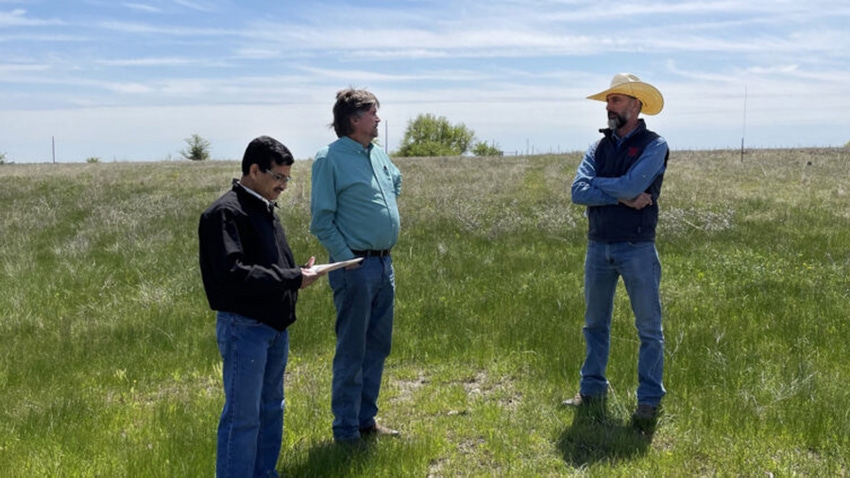April 18, 2023

Prolonged high stocking rates and livestock overgrazing can result in significantly less soil organic carbon and soil fertility on rangeland, according to a Texas A&M AgriLife-led study, which assessed key soil health indicators to determine the ecological effects of different grazing management.
In a study funded by the National Institute of Food and Agriculture, U.S. Department of Agriculture, Texas A&M AgriLife Research scientists in the Texas A&M College of Agriculture and Life Sciences recently published “Evaluating the impacts of alternative grazing management practices on soil carbon sequestration and soil health indicators” in the Agriculture, Ecosystems and Environment journal.
The research team said the study results will have important implications for ranchers and policymakers who seek to improve the ecological health of soils at the ranch and watershed scales.
“We know well-managed grazing lands can improve plant growth, forage recovery and soil fertility,” said Srinivasulu Ale, AgriLife Research agrohydrologist, Texas A&M AgriLife Research and Extension Center, Vernon, and the Department of Biological and Agricultural Engineering. “By contrast, continuous heavy defoliation of grasses can lead to soil and hydrological degradation in grazing lands.”
Through modeling, the research team was able to simulate the impacts of three grazing management practices—heavy continuous, light continuous, and adaptive multi-paddock, AMP, grazing, which is a form of rotational grazing—on soil organic carbon, soil health indicators and hydrological parameters. The research was conducted on a northwest Texas ranch and in a large-scale watershed.
Under AMP grazing, which is characterized by variable short grazing periods followed by extended post-defoliation plant recovery periods, especially for preferred forage species, there was an overall lower grazing intensity at both the ranch and watershed scales.
Higher carbon loads in soil entering the streams under heavy continuous grazing suggest that increased bare ground and soil compaction under the high grazing intensity reduced water infiltration and increased surface runoff and soil erosion. This and previous research have indicated that AMP grazing leads to less bare ground and decreased carbon losses from soil erosion than continuous grazing at the same stocking rate.
AMP grazing improvements
Study results indicated that by adaptively maintaining moderate growing-season defoliation with adequate plant recovery time, AMP grazing can minimize the negative effects of area selective overgrazing under continuous grazing and can enhance soil organic carbon, soil health and hydrological parameters.
“Our results indicated that, compared to the heavy and light continuous grazing, the average annual soil organic carbon was the highest under AMP grazing at both the study ranch and in the study watershed,” he said.
When the grazing management was changed from heavy continuous grazing to AMP grazing, average annual soil organic carbon increased by 2.7% at the study ranch and 7.6% in the study watershed, said Jungjin Kim, an AgriLife Research postdoc under Ale, who is now with the Institute of Environmental Technology at Seoul National University of Science and Technology. The biomass carbon and soil nitrogen increased, while carbon losses from runoff and sediment loads decreased under AMP grazing.
Additionally, relative to heavy continuous and low continuous grazing, AMP grazing had a significant positive effect on other soil and hydrological factors at the ranch and watershed scales, including primary productivity, biomass carbon and soil respiration, said Urs Kreuter, professor in the Department of Ecology and Conservation.
“Collectively, our results support the claims that AMP grazing has a high potential for restoring degraded grazing lands,” Ale said. “This finding counters the assertions by some researchers that the only necessary management variable for sustaining grazing land health and productivity is the maintenance of low to moderate stocking rates while allowing grazing animals to roam freely to maximize diet quality.
Research Team
The research team was led by Ale and Kim. Others on the team included Kreuter; Richard Teague, retired professor, AgriLife Research, Vernon; Stephen DelGrosso, USDA-Agricultural Research Service, Fort Collins, Colorado; and Steven Dowhower, retired AgriLife Research senior research associate, Vernon.
Source: Texas A&M AgriLife Extension, AgriLife Today
About the Author(s)
You May Also Like






